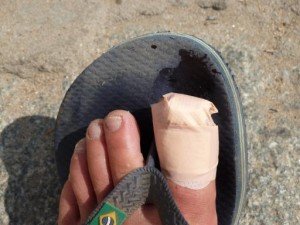A toe injury refers to any damage to the structures of the toe. Toe injuries are very common as most people are prone to foot injuries. Soft tissue injuries to the toe include lacerations, puncture wounds, abrasions and toenail injuries.
A person with a toe injury may experience toe pain, toe swelling, toe redness or bruising of the toe. Additional symptoms include cuts or lacerations, puncture wounds, toenail injury and deformity of the toe.
Treatment for toenail injuries generally involves resting the toe, cold compresses and elevation. Additional treatment options may also include protective footwear, toe splint, crutches, non-steroidal anti-inflammatory medication or acetaminophen for pain. Minor cuts and skin bruises may require wound cleansing and topical ointments. Severe fractures of the big toe may require surgery.
Disclaimer: this page on toe injury and its causes, signs, symptoms and treatment is for learning purposes only. To learn how to recognize and manage toe injuries and other minor and major injuries sign up for first aid and CPR classes with St Mark James.
Causes
Most toe injuries are caused when a toe hits a hard object or surface or when a heavy object is dropped on an unprotected toe.
Causes of toe injury may include:
- Automobile accidents
- Falls
- Occupational injuries
- Running
- Sports injuries
- Striking the toe onto a hard surface
- A heavy object dropped on the toe
Types
Common types of toe injuries include:
- Toenail injury
- Toe contusions
- Toe dislocation
- Toe fracture
Treatment
Treatment for toe injury may include:
- Toe wound cleansing
- Toe wound repair
- Elevation of the toe
- Cold compresses
- Rest – use a walker, cane or crutches
- Toenail injury treatment
- Open toe shoes
- Taping the injuries toe to the adjacent, uninjured toe – buddy tape toes
- Nonsteroidal anti-inflammatory medication for pain
- Narcotic pain medication for moderate to severe pain
- Surgery for complicated injuries and toe fractures
Home care treatment
Follow these home care steps to reduce the symptoms of toe injury:
- Take care of your wound as advised by your doctor
- Clean the affected skin gently. Use a mild soap and lukewarm water to cleansing
- Avoid scrubbing the skin
- Pat dry after washing the affected toe and apply a topical antibiotic ointment
- Apply cold compresses using ice wrapped in a moist hand towel. Avoid applying ice directly on the skin. Repeat every 1-2 hours for 20-30 minutes for the first few days of injury
- Keep the affected foot elevated
- Rest the injuries toe. Use a walker or cane or crutches
- Apply a splint or gauze as directed by your health care provider
- Tape the injured toe with the adjacent, unaffected toe
- Take nonsteroidal anti-inflammatory medication such as ibuprofen and naproxen for pain
- Take medication as directed by your doctor and avoid skipping doses
When to seek medical attention
See your doctor if any of the problems arise due to a toe injury:
- Worsening toe pain
- Worsening toe swelling
- Worsening tenderness of the toe over the bones
- Worsening skin redness around the wound
- Worsening skin swelling around the wound
- Deformity of the toe
- Deformity of the toenail
- Inability to stand on the affected foot
- Inability to walk or over the affected toe
Additional Information
To learn more about toe injuries, symptoms, signs and treatment enrol in St Mark James first aid and CPR classes with one of our training providers.
Related Articles
Related Video
http://www.youtube.com/watch?v=93PVTLHWNLI

